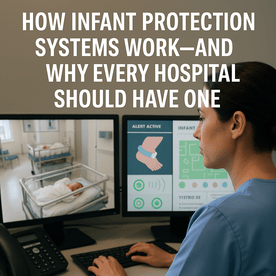
For hospitals with labor & delivery units, neonatal ICUs, or pediatric care facilities, protecting newborns isn’t just about clinical care—it’s about total safety. Infant abduction remains rare, but the risk is real, and even a single incident can devastate families, damage reputations, and jeopardize regulatory standing.
That’s where infant protection systems come in. These specialized solutions are designed to track, monitor, and safeguard newborns from the moment they’re born until discharge. But to do that effectively, the system must be more than just a tag—it has to integrate seamlessly with hospital operations and security infrastructure.
In this blog, we’ll break down how modern infant protection systems work, what makes them effective, and why every hospital that cares for infants should implement one.
k
k
Why Infant Security Matters—Even When the Risk Is Low
The perception of safety in a maternity or neonatal unit is almost as important as the actual safeguards. Families expect:
-
Controlled access to newborn areas
-
Confident, security-aware staff
-
Immediate responses to any irregular movement or incident
Infant abductions are rare—but when they happen, they often involve unauthorized removal of an infant by a stranger, family member, or impersonator. More commonly, risks come from unauthorized handling, wrong-patient errors, or infant switching.
A robust infant protection system prevents incidents and builds family trust, which supports overall patient satisfaction and hospital reputation.
k
k
How Infant Protection Systems Work (Step-by-Step)
Here’s how a modern system functions, from admission to discharge:
1. Infant Tagging and Pairing
At birth or admission, each infant is fitted with a tamper-resistant tag, typically worn on the ankle or wrist. The tag:
-
Sends a unique, encrypted signal to nearby receivers
-
Can be paired with the mother’s ID band for validation
-
Is designed to detect tampering or removal attempts
These tags are lightweight, skin-safe, and continuously monitored.
k
k
2. Zone-Based Tracking and Movement Monitoring
The hospital is equipped with RFID, Wi-Fi, or infrared receivers placed throughout:
-
Maternity wards
-
Hallways and exits
-
Elevators and stairwells
If an infant is moved beyond an authorized zone, the system triggers an alert—locking nearby doors, disabling elevators, and notifying staff.
k
k
3. Real-Time Alerts and Staff Notification
If a tag is tampered with, removed, or crosses a protected threshold, alerts can be configured to:
-
Sound audible alarms at nursing stations
-
Send push notifications to mobile security devices
-
Trigger video surveillance feeds to auto-focus on the event
-
Initiate localized lockdowns of doors and elevators
This real-time functionality ensures that no one has to “check the monitor”—the system reaches them immediately.
k
k
4. Integration with Access Control and Surveillance
Leading systems integrate with:
-
Hospital access control (locking down exits instantly)
-
Surveillance systems (linking video with tag events)
-
Infant matching platforms (verifying identity before transport or procedures)
This interoperability ensures no step is manual, and no alert goes unseen.
k
k
5. Event Logging and Audit Trail
Every event—from tag placement to alarm response—is logged. This supports:
-
HIPAA and Joint Commission compliance
-
Post-incident review and training
-
Discharge validation (confirming correct patient movement and procedures)
Logs can be accessed by authorized personnel for quality assurance and compliance audits.
k
k
Benefits of Infant Protection Systems for Hospitals
| Benefit | Why It Matters |
|---|---|
| Patient safety | Prevents abduction, wrong-patient errors, and mishandling |
| Family confidence | Builds trust in the hospital’s safety standards |
| Regulatory compliance | Supports audits, Joint Commission readiness |
| Staff efficiency | Reduces manual tracking, enables fast intervention |
| Reputation protection | Minimizes legal and PR risks from preventable incidents |
What to Look for in a Quality Infant Protection System
When evaluating a system, look for these key features:
-
Tamper-detection and real-time alerts
-
Integration with access control and VMS
-
Wireless coverage without dead zones
-
Secure pairing with caregiver bands
-
Mobile alerting for on-the-go staff
-
Audit trail and reporting tools
-
Scalable architecture for future expansion
Bonus points if the system uses open architecture, which makes integration with other hospital platforms simpler and more flexible.
k
k
Real-World Scenario: How Infant Protection Works in Action
Imagine this scenario:
A mother is being discharged and a nurse brings the infant to the room. The infant’s RFID tag is scanned and automatically paired with the mother’s band. A notification confirms a match.
Later, an unauthorized person attempts to exit the unit with the infant. The system:
-
Detects movement into a restricted hallway
-
Locks the exit door
-
Triggers a silent alarm at the nurse’s station
-
Redirects nearby surveillance cameras
-
Sends a mobile alert to hospital security
Security intervenes in seconds—before the infant leaves the unit.
k
k
Conclusion: No Excuses for Gaps in Infant Protection
Today’s hospitals can’t afford to treat infant protection as optional or outdated. These systems are proven, integrated, and designed to fit smoothly into daily operations—while providing one of the highest-impact safeguards a facility can offer.
Infant protection is about more than preventing the unthinkable. It’s about giving families peace of mind, staff confidence, and leadership assurance that every child is safe from day one.
Talk to SSP about implementing or upgrading an infant protection system tailored to your facility. We help hospitals design integrated safety solutions that protect what matters most.


